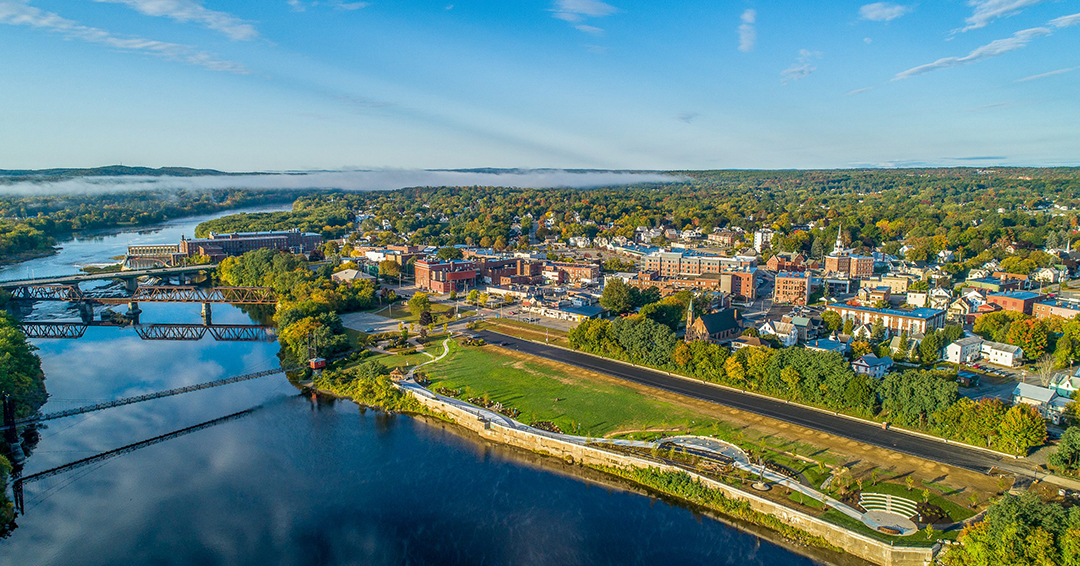BRIDGEPORT, Pa. — For fans heading to Colby College in Waterville, Maine, for the 2025 Women’s National Collegiate Club Championship on Friday-Sunday, April 11-13, the Collegiate Water Polo Association (CWPA) provides information about the town and the local area:
A Little About Waterville, Maine: Located in Kennebec County, Maine, on the west bank of the Kennebec River, Waterville is home to both Colby College and Thomas College and was dubbed the “Elm City” for its many elm trees,
As of the 2020 census the population was 15,828, The city is served by Interstate 95, U.S. Route 201, and Maine State Routes 137 and 104. It is bordered by Fairfield on the north in Somerset County, Winslow on the east, Sidney on the south and Oakland on the west.
The area now known as Waterville was once inhabited by the Canibas tribe of the Abenaki people. Called “Taconnet” after Chief Taconnet, the main village was located on the east bank of the Kennebec River at its confluence with the Sebasticook River at what is now Winslow. Known as “Ticonic” by English settlers, it was burned in 1692 during King William’s War, after which the Canibas tribe abandoned the area. Fort Halifax was built by General John Winslow in 1754, and the last skirmish with indigenous peoples occurred on May 18, 1757.
The township would be organized as Kingfield Plantation, then incorporated as Winslow in 1771. When residents on the west side of the Kennebec found themselves unable to cross the river to attend town meetings, Waterville was founded from the western parts of Winslow and incorporated on June 23, 1802. In 1824 a bridge was built joining the communities. Early industries included fishing, lumbering, agriculture and ship building, with larger boats launched in spring during freshets. By the early 1900s, there were five shipyards in the community.
Ticonic Falls blocked navigation farther upriver, so Waterville developed as the terminus for trade and shipping. The Kennebec River and Messalonskee Stream provided water power for mills, including several sawmills, a gristmill, a sash and blind factory, a furniture factory, and a shovel handle factory. There was also a carriage and sleigh factory, boot shop, brickyard, and tannery. On September 27, 1849, the Androscoggin and Kennebec Railroad opened to Waterville. It would become part of the Maine Central Railroad, which in 1870 established locomotive and car repair shops in the thriving mill town. West Waterville (renamed Oakland) was set off as a town in 1873. Waterville was incorporated as a city on January 12, 1888.
The Ticonic Water Power & Manufacturing Company was formed in 1866 and soon built a dam across the Kennebec. After a change of ownership in 1873, the company began construction on what would become the Lockwood Manufacturing Company, a cotton textile plant. A second mill was added, and by 1900 the firm dominated the riverfront and employed 1,300 workers. Lockwood Mills survived until the mid-1950s. The iron Waterville-Winslow Footbridge opened in 1901, as a means for Waterville residents to commute to Winslow for work in the Hollingsworth & Whitney Co. and Wyandotte Worsted Co. mills, but in less than a year was carried away by the highest river level since 1832. Rebuilt in 1903, it would be called the Two Cent Bridge because of its toll. In 1902, the Beaux-Arts style City Hall and Opera House designed by George Gilman Adams was dedicated. In 2002, the C.F. Hathaway Company, one of the last remaining factories in the United States producing high-end dress shirts, was purchased by Warren Buffett’s Berkshire Hathaway company and was closed after over 160 years of operation in the city.
Waterville also developed as an educational center. In 1813, the Maine Literary and Theological Institution was established. It would be renamed Waterville College in 1821, then Colby College in 1867. Thomas College was established in 1894. The Latin School was founded in 1820 to prepare students to attend Colby and other colleges, and was subsequently named Waterville Academy, Waterville Classical Institute, and Coburn Classical Institute; the Institute merged with the Oak Grove School in Vassalboro in 1970, and remained open until 1989. The first public high school was built in 1877, while the current Waterville Senior High School was built in 1961.
How Do I Know the Name Waterville?: The 2001 satirical comedy movie Wet Hot American Summer is set in a fictional summer camp near Waterville, with some scenes taking place in the city. The movie was filmed in Pennsylvania, but signs displaying “Waterville Maine Est. 1802 Pop. 17,173” and “Waterville C.B. Radio Supply Inc.” are shown in these scenes.
The town was also a filming location for “Empire Falls”, a 2005 two-part Home Box Office (HBO) mini-series starring Ed Harris, Helen Hunt, Philip Seymour Hoffman, Dennis Farina, Joanne Woodward, and Paul Newman (in his last live action role) based on the 2002 Pulitzer Prize for Fiction winner.
Who is Colby College Named For?: The namesake of Colby College, Gardner Colby (1810–1879) was a prominent businessman and Christian philanthropist. He was born in Bowdoinham, Maine in 1810 and spent part of his childhood in Waterville, Maine. His father, Josiah Colby, died in 1814 after having lost his fortune during the War of 1812, and had spent time manufacturing gunpowder in Waterville before his death. To aid Colby’s mother, Jeremiah Chaplin, a Baptist minister who served as the first President of Waterville College (now Colby College) arranged for the Colby family to operate a store in Charlestown, Massachusetts. Gardner Colby eventually started his own store in Boston and became involved in various other businesses including railroads, shipping and manufacturing. During the Civil War in 1864 the college in Waterville was facing hardships, so Colby made the first of several large donations to the college and it was subsequently renamed “Colby University” in his honor. He served as a trustee from 1864 to his death and many of his descendants became involved with the school.
How to Get to Waterville: The closest airports to Waterville, Maine are Augusta (AUG), Bangor (BGR) and Portland (PWM).
- Augusta (AUG): 18.1 miles away
- Bangor (BGR): 44 miles away
- Portland (PWM): 71.4 miles away
- Boston (BOS): 167.2 miles away
Other Events on Campus: Fans attending the championship should be aware that Colby is also hosting women’s tennis (vs. Amherst College), women’s lacrosse (vs. Trinity College, Conn.) and softball (vs. Wesleyan University) on Saturday, April 12, along with women’s tennis (vs. Hamilton College) on Sunday, April 13, which might impact hotel availability.




